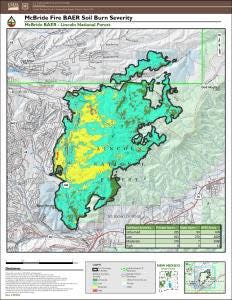How to prepare for monsoon flooding in New Mexico post-fire areas
The McBride and Nogal Canyon Fires were declared 100% contained in early May, and now residents in the affected areas face the possibility of flooding once monsoon rains begin later this summer.
"Everyone near and downstream from the burned areas should remain alert and stay updated on weather conditions that may result in heavy rains and increased water runoff," a Burned Area Emergency Response (BAER) safety response states. "Flash flooding may occur quickly during heavy rain events-be prepared to act."
Monsoon season is generally between June 15 and Sept. 30.
Some monsoon rainstorms can cause high water runoff and flooding downstream from wildfire burn scars.

"Wildfire increases the potential for flooding, post-fire soil erosion and debris flows that could impact campgrounds, fishing areas, homes, structures, roads, and other infrastructure within, adjacent to, and downstream from the burned areas," the post-fire BAER message states. "Post-fire, watershed conditions will naturally receive and transport water and sediment differently than during pre-fire conditions."
People who live in communities adjacent to or downstream from wildfire areas should expect increased flooding risk even in smaller rainstorms.
More: Assessment of McBride Fire's burn impact still underway
The BAER message adds ways to prepare for flooding and debris flows following a wildfire.
For properties and resources that may be impacted by flooding that are not on federal lands is interagency coordination with local organizations that help affected businesses, homes and landowners prepare for rains that could become flooding issues, the BAER message states.
Sign up for our newsletter, the Daily Briefing, to get stories like this one delivered straight to your inbox every morning.
One way residents can protect their property from flooding is through the USDA Natural Resources Conservation Service (NCRS) Emergency Watershed Protection (EWP) Program that provides financial and technical assistance for certain things.
These include:
debris removal from stream channels, road culverts and bridges
reshape and protect eroded streambanks
correct damaged drainage facilities
establish vegetative cover on critically eroding lands
repair levees and structures
repair conservation practices
Public and private landowners can apply for assistance for EWP Program – Recovery projects through a local sponsor, or a legal subdivision of state or tribal government. Eligible sponsors include cities, counties, towns, conservation districts, flood and water control districts, or any federally-recognized Native American tribe or tribal organization, according to the program's website.
One local sponsor is the Village of Ruidoso which has an EWP application for those affected by the McBride Fire that is available on the Village of Ruidoso website or at Ruidoso Village Hall, 313 Cree Meadows Drive in Ruidoso.
For more information, call the Village of Ruidoso at 575-258-4343,
Nicole Maxwell can be contacted by email at nmaxwell@alamogordonews.com, by phone at 575-415-6605 or on Twitter at @nicmaxreporter. If you have questions about your subscription, please contact Customer Service at AlamogordoDailyNews@Gannett.com or call 1-877-301-0013.
This article originally appeared on Alamogordo Daily News: How to prepare for monsoon flooding in post-fire areas

